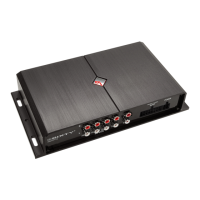1312
EQ Setup
EQ Graph
The upper right of the UI displays the EQ graphically for the channel(s) selected. The EQ graph will start with a perfectly flat response (20-20KHz) when first
setting up your equalizer, then any changes/additions to the 31 band EQ, filters, or Q, will be displayed in the EQ graph.
NOTE: The EQ graph will not
display a perfectly flat
response when first tuning
a vehicle if the “Auto
Normalize” function was
used during configuration.
Instead you will see the
corrections the “Auto
Normalize” made to the
31 Band EQ to flatten the
selected channel(s) its
response.
EQ Controls
The lower half of the UI is used to control the 3Sixty.3 processor’s 31 parametric band EQ. Every channel has its own independent (unless linked) EQ
adjustments. The EQ adjustments can be broken down into three separate sections Crossover Network(s), Level & Delay, and the 31 Band EQ Adjustments.
Crossover Network(s)
The crossover adjustments consist of three parts; Crossover Type, Crossover Class, and Crossover Slope.
Crossover Type
The crossover type for each channel can be configured as either high-pass (HPF), low-pass (LPF), band-pass (BPF), low-shelf (LSF), high-shelf (HSF) or
completely by-passed (AP). After selecting the crossover type, you will need to enter the frequency(s) you would like your filter(s) to cutoff at. Below the
crossover slope selection tab there is a box for entering high filter values and low filter values depending on the crossover type you previously selected.
Crossover Class
The crossover class for each channel can be configured as either Linkwitz (Q=0.49), Bessel (Q=0.58), Butterworth (Q=0.707), or Chebychev (Q=1.0). If you
are not sure which class to use we recommend starting with a Butterworth filter because of its flat response characteristics.
Crossover Slope
The crossover slope for each channel can be configured as either 12dB/octave, 24dB/octave. 36dB/octave, 48dB/octave The steeper then slope, the faster
the roll-off, resulting in less content passing through the device from the unwanted frequency range.
NOTE: If you are unsure as to the correct setting, consult your local Authorized Rockford Fosgate dealer for correct recommended setting for your
specific system.
EQ Setup
Preferences
The preferences menu is used to set up the general settings of the processor, remote control, and
bluetooth dongle.
General
a)The General menu allows you to select the EQ Delay Units to be displayed in ft, in, m, or cm
b)The General menu also allows you select the Remote Output Delay Timing. 1 sec, 2 sec, 4 sec, or 8
sec. This allows the user to customise the time delay from when the 3Sixty
.3 initializes (turns on) to
when it turns on any external amplifiers connected to its REM OUT (blue wire in 4 pin power harness)
This allows the user to ensure that the source unit, and 3Sixty.3 are on and initialized before turning
on the amplifiers, therefore eliminating any turn on “pop” noise.
Remote
a)The Remote menu allows you to select the Mounting Orientation of the wired remote control to be either normal or inverted.
b)The Remote menu also allows you to select the function for each knob. There are three options for two knobs; Master Volume, Sub V
olume, and Punch
EQ. You cannot however have both knobs perform the same function.
Bluetooth
a) The Remote menu allows you to name your BT dongle.
b) The Remote menu allows you to configure a PIN number security password that will be required before your hands free device can sync to your 3Sixty
.3.
c) The Remote menu also allows you to enable or disable “Auto Play” by checking the selection box. The “Auto Play” feature automatically switches your
input source to BT when your BT device sends a notification or is playing music.
NOTE: The factory default pin number is set to (0000).
NOTE:
When “Auto Play is enabled there is a 7sec delay when switching from BT
to any other source on output channels 5,6,7, & 8.
Main UI Screen.
The 3Sixty.3’s main page can be broken down into four main sections, Speaker
Selection, EQ Graph, EQ Controls, and WRC simulator. It is also used to display the
current preset that is loaded, device connection status, and software update status.
Speaker Selection
The upper left of the UI displays a picture of a vehicle with the speakers (channels)
displayed that were initialized in the Assign Input/Output section of the initial
configuration. Each speaker (channel) can be configured individually or you can link
together channels using the check boxes to the right of the vehicle illustration. For convenience the
sub woofer channels just have one check box to link the level, crossover, and EQ. By selecting to link
the left and right channel level, crossover, or EQ together what you do with one side will be duplicated
to the other side. The speaker (channel) that is selected will be highlighted blue and the channels
name will be displayed above the vehicle diagram.
NOTE: If the speakers represented in the vehicle speaker selection display do not represent the
speakers in your vehicle you will need to configure the Assign Input/Output section of the
initial configuration.
NOTE: If the “Auto Normalize” function was used during configuration, each channel has its own
EQ correct curve. If you choose to link the EQ for multiple channels the EQ curve of the
selected channel will be copied to all the other linked channels.

